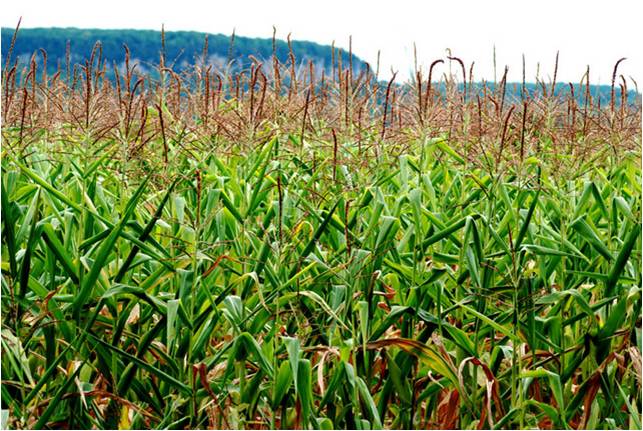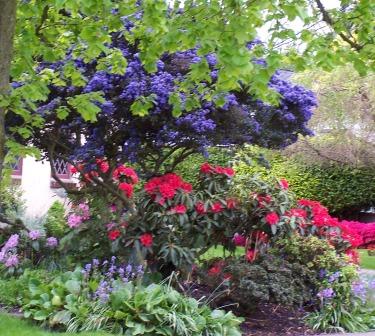Last week Jeff wrote about the dangers of using “balanced” fertilizers, especially in reference to phosphorus content. Comments quickly followed about using fertilizers in many situations – on farms, in container plants, on trees – and so on. One of the latest comments came from Nick and began “I don’t usually recommend fertilizer for perennials or woody plants to consumers. In most cases they aren’t needed.” And this leads into today’s topic.
Many of the horticultural practices we use in our gardens and landscapes have, unfortunately, been derived from agricultural crop production. Whether you’re growing a field of wheat, garden tomatoes, or containerized shrubs your goal is maximizing crop production. By its nature, this is an unsustainable practice because it requires continual inputs of water and nutrients at higher levels than would naturally occur.

But this is not how you should care for landscape trees and shrubs, and why Nick’s comment was a good one. You don’t need to routinely add fertilizer to these plants; they don’t need it to grow normally. What we should be doing in landscapes is preventing nutrient deficiencies. Once you have a soil test in hand, you’ll know what nutrients may be too low (or too high) and how soil pH will affect that. For most of us, this may involve occasionally adding one of a few nutrients (most commonly nitrogen), or perhaps acidifying the soil to improve nutrient availability.

How do you know when to add nitrogen to established landscape plants? Let your foliage do the talking. If leaves are uniformly yellow, small and sparse, you might have a nitrogen deficiency. This will be most common in the mid to late summer, when plants are growing most rapidly and competing with one another for resources. Be sure this symptom is wide-spread, however. If it’s just one plant showing deficiency symptoms, it’s probably not a landscape issue.

Thanks for the informative post. I don’t believe in adding fertilizer to my plants unless they need it. I’ve found that excessive fertilizer is a much bigger risk than too little fertilizer.
Feed the soil, not the plants. Don’t get me started on organic mulch again.
I only use fertilizer in pots. What does a “balanced” fertilizer do in pots over time, like years?
My philosophy is if a plant doesn’t like the acidity (or alkalinity) of my soil, I get rid of it. Doctoring the soil to make a plant happy is a losing game, a temporary fix under most conditions.
Good point, Deirdre, about organic mulch. I’ve beaten that drum so often I decided not to this time. You’re also correct that people should choose plants that tolerate their soil’s natural pH. My suggestion about acidifying the soil was aimed at those people with temporary alkalinity problems due to new concrete structures. Once the lime has leached out of the cement, soil pH should return to what’s natural for the c
limate.
Deirdre forgot to mention that over time fertilizer salts tend to build up in pots. I don’t know what the nutrient balance in the soil is, however. It’s a good question. I’d guess it’s probably high in phosphorus.
Linda, show some sympathy for the poor tree care companies that have nothing to do with their expensive spray trucks when their schedules of excessive spray regimen are interrupted by rain. Without bogus “deep root” fertilization to fill those days they would lose their competitive edge to other companies that do the same thing.
I have a feeling that this fertilization combined with a tendency to excessively thin interior wood rushes specimen trees too an early death. In trees, being more compact is a good survival trait.
Also, maybe you could do another article looking into whether and how excessive N applied to lawns and woodies leads to increased vulnerability to disease and insect damage. There must be some interesting research out there on the subject.
That’s an excellent idea. There is research demonstrating that over-fertilized plants put fewer resources into some defensive chemicals. Not sure I can get it done in time for this week, but I will definitely do it!
If I wait for plants to show me their problems then I am reactive. I used to care for a large private estate where the owner expected her plants to represent healthy specimens not ones where her gardener waited until the foliage was discolored to take action. Not to mention the first symptoms are often followed by more stressed foliage. In the case of queen palms here in San Diego the lack of regular fertilization has lead to a population of sickly looking palms carrying less fronds than the species should. Waiting for these plants to exhibit symptoms only means a frustrating game of catch-up which many soon tire of and give up.
Tim, in the case of fertilizers I think reacting to symptoms (and armed with a soil test) is preferable to overuse of fertilizers. Many “deficiency” symptoms are actually due to nutrient toxicity; phosphorus toxicity is linked to interveinal chlorosis, for instance. Urban landscapes are rarely deficient in any nutrient save nitrogen. Unless you know what your soil nutrient levels are, how can you be sure you’re adding the right stuff?
You’ll get no argument from me on preventing overuse. The soil lab loved me because I was indeed a regular customer. I still prefer a proactive approach as to reactive. Once again I point to many of the feather palms we grow in San Diego. It’s an epidemic of under fertilization and the palms are far from aesthetically acceptable. Definitely a case where proactive is better. Manganese deficient fronds can’t be fixed and will be held in the palm for a long time. Yellowed magnesium deficient queen palm fronds can’t be made green with the application of fertilizer. So if I wait then I am stuck with them.
Tim, I agree that palms are a bird of a different feather (sorry for the bad pun). Their care and feeding is unlike anything else in the landscape.
Thanks for the idea of the landscape. Based on my experience that cutting the grass too short was a problem. We like to cut it short because we don’t have to cut it again for a while, but I’ll try to remember to do this.